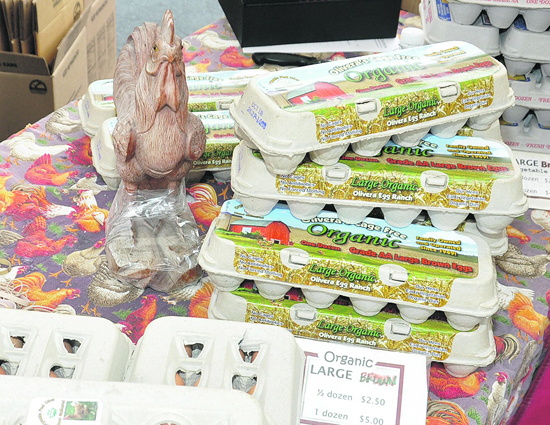 | | | Organic eggs at the Olivera Egg Ranch booth at the Moraga Farmers' Market
Photo Andy Scheck
| | | | | |
Lamorinda has attracted wonderful food purveyors, and some of the finest grocery shops are available minutes from home. My patients have often inquired if buying organic foods is necessary for good health. There are many opinions about this topic. Mine is that certain foods are healthier when organically grown, and others can safely be purchased as conventionally grown. I'll explain further and then share some lists to help both your budget and health guide you through the grocery aisles.
 In 2009 and 2011, The Center for Disease Control released the results of studies on chemical exposure and wrote the Fourth National Report on Human Exposure to Environmental Chemicals. They found that most Americans tested positive for the presence of 212 chemicals and heavy metals. The six most widespread chemicals were: PDE (flame retardant), BPA (food-related plastics), Acrylamide (fried foods), PFDA (nonstick cookware), Mercury (seafood), and MTBE (gasoline). Studies show these toxins to be correlated with allergies, diabetes, infertility, and neurological and autoimmune conditions. Some, for example dioxin, are no longer used but are still found in dairy products, farm-raised fish and beef. (Dioxin is a known contributor to the development of type 2 diabetes - see reference 5).
In 2009 and 2011, The Center for Disease Control released the results of studies on chemical exposure and wrote the Fourth National Report on Human Exposure to Environmental Chemicals. They found that most Americans tested positive for the presence of 212 chemicals and heavy metals. The six most widespread chemicals were: PDE (flame retardant), BPA (food-related plastics), Acrylamide (fried foods), PFDA (nonstick cookware), Mercury (seafood), and MTBE (gasoline). Studies show these toxins to be correlated with allergies, diabetes, infertility, and neurological and autoimmune conditions. Some, for example dioxin, are no longer used but are still found in dairy products, farm-raised fish and beef. (Dioxin is a known contributor to the development of type 2 diabetes - see reference 5).
 There are nutritional approaches which aim to decrease the toxin burden on the liver which I think are helpful but are a topic for another article. Regarding future exposure to toxins, I think that the "cleaner" the food eaten, the less the body is burdened over time. Below are lists I have developed and those adopted from other food educators. I dubbed the first list the "Scary Six" because they are highest on the food chain and are high-fat (toxins concentrate in fat tissue). The other lists describe fruits and vegetables according to their average amounts of pesticide and fertilizer residues. Load these lists on your cell phone so you'll have them handy when grocery shopping):
There are nutritional approaches which aim to decrease the toxin burden on the liver which I think are helpful but are a topic for another article. Regarding future exposure to toxins, I think that the "cleaner" the food eaten, the less the body is burdened over time. Below are lists I have developed and those adopted from other food educators. I dubbed the first list the "Scary Six" because they are highest on the food chain and are high-fat (toxins concentrate in fat tissue). The other lists describe fruits and vegetables according to their average amounts of pesticide and fertilizer residues. Load these lists on your cell phone so you'll have them handy when grocery shopping):

 THE "SCARY" SIX
THE "SCARY" SIX
 *(Buy Organic)
*(Buy Organic)
 1. Dairy products
1. Dairy products
 2. Eggs
2. Eggs
 3. Farm-raised Fish
3. Farm-raised Fish
 4. Meat
4. Meat
 5. Peanut butter/nuts
5. Peanut butter/nuts
 6. Poultry
6. Poultry

 THE DIRTY DOZEN
THE DIRTY DOZEN
 *(Buy Organic)
*(Buy Organic)
 1. Apples
1. Apples
 2. Bell peppers
2. Bell peppers
 3. Blueberries
3. Blueberries
 4. Celery
4. Celery
 5. Cherries
5. Cherries
 6. Grapes
6. Grapes
 7. Kale/ other greens
7. Kale/ other greens
 8. Nectarines
8. Nectarines
 9. Peaches
9. Peaches
 10. Potatoes
10. Potatoes
 11. Spinach
11. Spinach
 12. Strawberries
12. Strawberries

 THE CLEAN FIFTEEN *(Okay to Buy Conventional)
THE CLEAN FIFTEEN *(Okay to Buy Conventional)
 1. Asparagus
1. Asparagus
 2. Avocado
2. Avocado
 3. Cabbage
3. Cabbage
 4. Cantaloupe
4. Cantaloupe
 5. Corn
5. Corn
 6. Eggplant
6. Eggplant
 7. Grapefruit
7. Grapefruit
 8. Honeydew/ melons
8. Honeydew/ melons
 9. Kiwi
9. Kiwi
 10. Mangoes
10. Mangoes
 11. Onions
11. Onions
 12. Pineapple
12. Pineapple
 13. Sweet peas
13. Sweet peas
 14. Sweet potatoes
14. Sweet potatoes
 15. Watermelon
15. Watermelon
 While these lists aim to consider both budget and health factors, it is true that organic foods are still more expensive. My recommendation re: where to spend, is to pay the most attention to the Scary Six (food sources higher on the food chain). As organic and local foods gain in popularity, prices will lower and everyone will benefit. Bon appetit and To Your Health! While these lists aim to consider both budget and health factors, it is true that organic foods are still more expensive. My recommendation re: where to spend, is to pay the most attention to the Scary Six (food sources higher on the food chain). As organic and local foods gain in popularity, prices will lower and everyone will benefit. Bon appetit and To Your Health!
 References:
References:
 1. http://www.cdc.gov/exposurereport/
1. http://www.cdc.gov/exposurereport/
 2. www.foodnews.org
2. www.foodnews.org
 3. JAMA (Journal American Medical Association) 2008;300:1353-54.
3. JAMA (Journal American Medical Association) 2008;300:1353-54.
 4. Bland, Jeffery, PhD. "Nutritioneering"
4. Bland, Jeffery, PhD. "Nutritioneering"
 5. Environmental Health Perspectives; Vol. 114/#11/Nov 2006
5. Environmental Health Perspectives; Vol. 114/#11/Nov 2006


|

